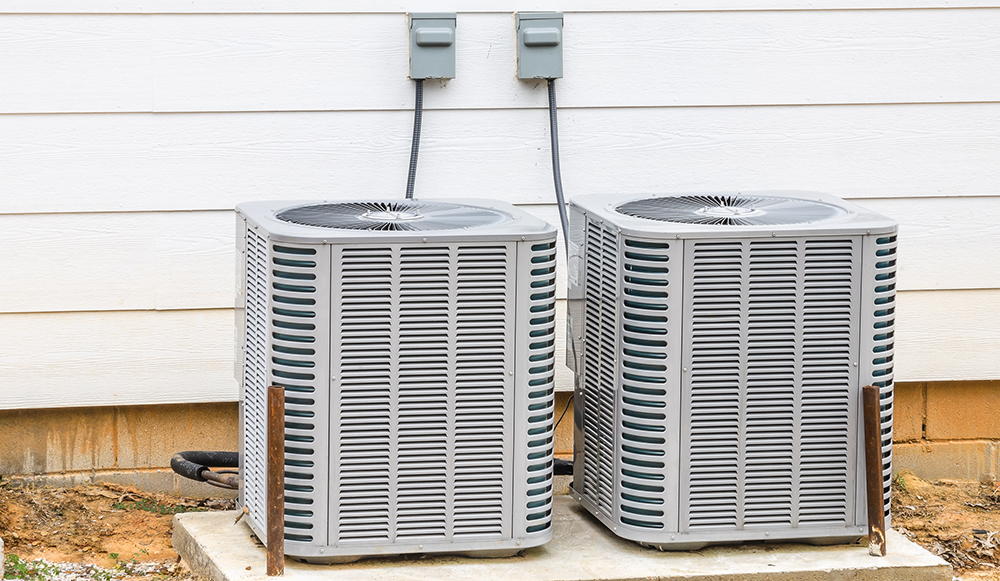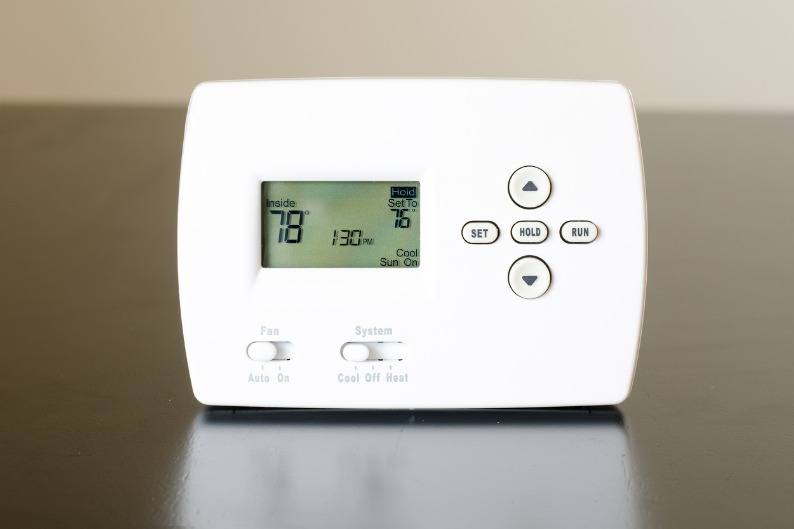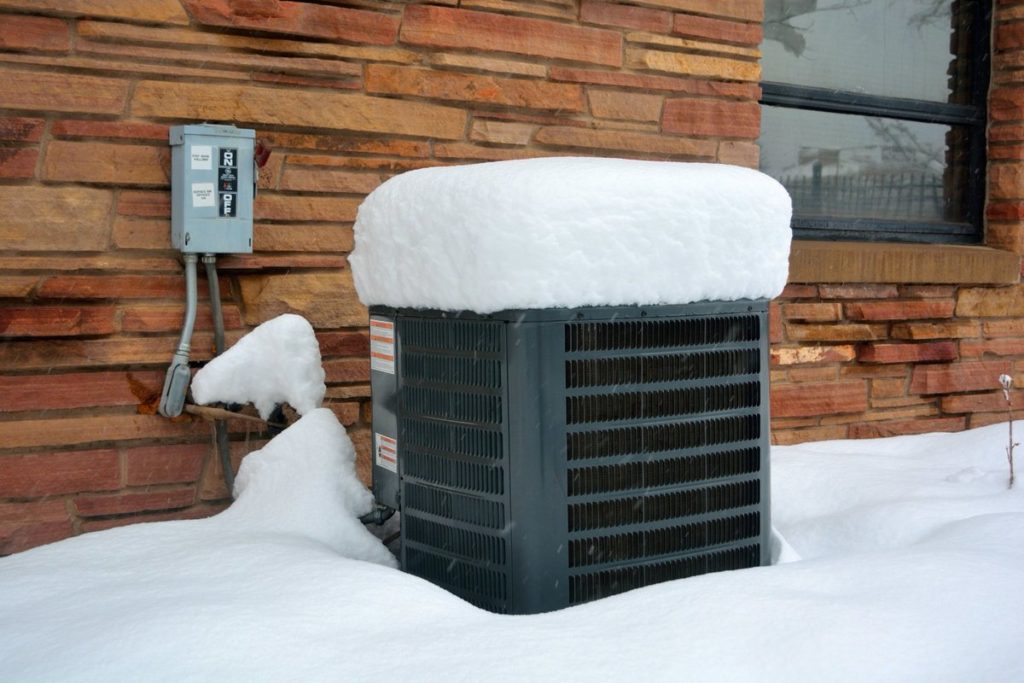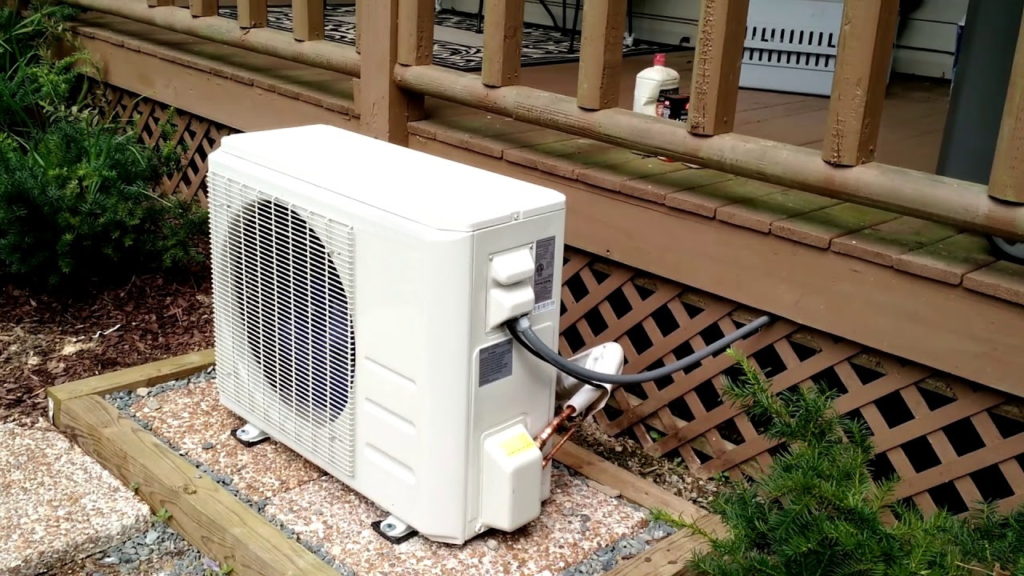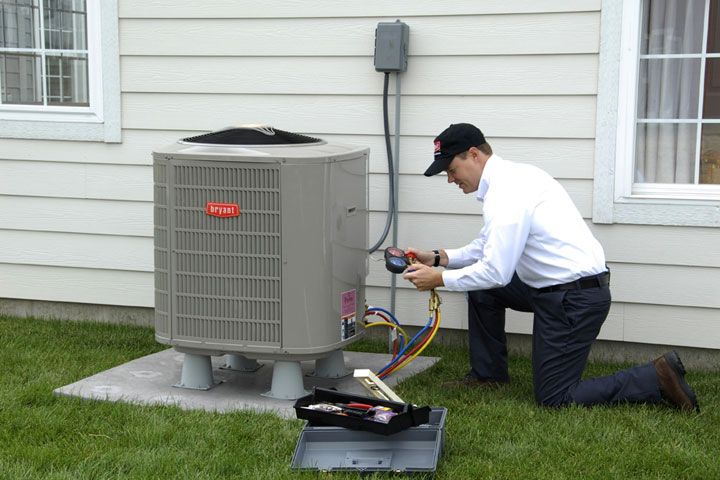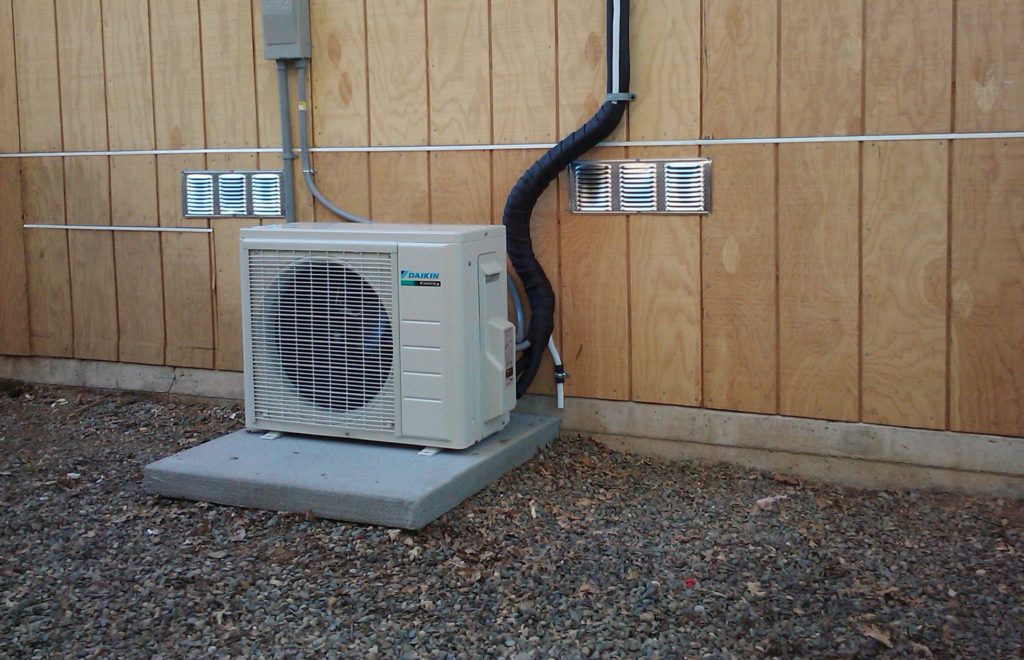

Do you find that your HVAC bills are way too high? Do you wish there was a way to lower your power consumption while still heating and cooling your home? Luckily, Amana has the solution with its selection of heat pumps. These units provide efficient heating and cooling and offer exceptional durability.
To help you make an informed decision, we’ve compiled our extensive Amana heat pump reviews. Several features were considered when rating these heat pumps. First, we looked at BTUs, which tells about the performance of the unit. The fewer BTUs, the less energy the heat pump is using. Next is the efficiency rating of the heat strips that use electricity to heat the air. You also want to take into account the voltage the unit will need to run properly. And finally, we’ll look at the unit’s dimensions to see how much room it will take up. Keeping these criteria in mind, let’s take a closer look at the Amana heat pumps!
More features: 4-way adjustable air throw, 2 fan speeds, slide-out chassis, remote control, slide-out filter, quiet operation
The Amana 12,000 BTU Through-The-Wall Air Conditioner provides a lot of value for a reasonable price. The slide-out chassis allows for easy installation and access for service when needed. Also, you have the option to purchase a separate wall sleeve for a simpler installation. The removable condenser cover allows for easy cleaning of the outdoor coils. The air filter slides out for easy removal and cleaning. If ease of maintenance is a priority, this unit is perfect.
This unit comes with an electronic touchpad and remote control to easily set the temperature of your heat pump. The fan has 2-speed and 4-way adjustable air throws to place airflow where you need it most. This unit is also quiet, so you do not have to worry about this heat pump keeping you awake.
What we liked: The easy cleaning design of this unit is a huge selling point. The areas such as air filters and condenser coils are easy to access and maintain.
What could be better: As quiet as this unit can be, the condenser can be a bit noisy. Customers have mentioned it can get loud when it kicks on, though it quiets down.
More features: increased dehumidification capacity, pull-out filter, 7-button touchpad, Eden control board, remote control, zero floor clearance
If an upgrade for more BTUs is your goal, then the Amana 17,000 BTU Air Conditioner with Heater will be perfect for you. The 7-button touchpad, Eden control board, and the remote control allow for easy setting for your comfort. The indoor tangential fan is quiet and provides for optimal air distribution.
The removable pull-out air filter allows for easy cleaning. Also, this air unit has a dehumidification capacity, which makes it perfect for reducing allergens in the air. Next, there is a freeze prevention sensor that activates when the room temperature reaches below 40°F.
What we liked: This unit is quiet and allows for lots of control options. The onboard sensors allow for easy maintenance and prevention of the unit overloading.
What could be better: With the variety of controls, some customers find the unit difficult to use. Sometimes less is more, and customers can suffer from option overload.
More features: fits standard wall sleeve, pull-out filter, Eden control board for energy saving, 3.0 COP rating
The Amana PTAC 15,000 BTU Air Conditioner Unit is one of the best heat pumps offered by Amana. It fits most standard wall sleeves and has the Eden control board to help save energy. On top of that, the wireless Eden EMS system can reduce energy costs by up to 35%. With the Eden monitoring system, you can check the performance as well as target maintenance issues.
This unit also is designed to run quietly to increase comfort with this air conditioner and heat pump. The two-speed indoor motor and triangulation fan allows for easy adjustment for comfort, and the outdoor fan allows for less noise inside the room. Thus, this unit is perfect for large zones that may have multiple areas that need to be kept heated or cooled and need an energy-efficient system.
What we liked: This unit is perfect for guest rooms with its compact design and quiet performance. Being able to deliver 15,000 BTU and having a 9.7 EER rating makes this a powerful and energy-efficient choice.
What could be better: Some customers have mentioned operation issues after a few years of use. Another issue is customer service when trying to obtain repairs or replacement parts.
More features: Eden control board, quiet indoor fan, pull-out filter, fits standard wall sleeve
When heating and cooling a smaller room like a hotel or studio apartment, the Amana PTAC 12,000 BTU Heat Pump Unit is the perfect fit. Its Digismart Eden control board increases the unit’s energy-saving capacity and provides a lot of heat and cool air while not using up too much power. This heat pump fits easily into standard wall sleeves.
The dual-fan design allows for maximum airflow with a quiet running operation that won’t disturb you or your guests. The seven-button Digismart touchpad allows for plenty of comfort settings to control the temperature in the room.
What we liked: For the price, this unit cannot be beaten for what it offers. Its easy installation and energy-efficient controls make this great for smaller rooms.
What could be better: Some customers have mentioned noise when the air compressor is engaged. While it is not a huge drawback, it could disturb you or your guests’ sleep if they are light sleepers.
More features: Eden control board, quiet indoor fan, fits standard wall sleeve, pull-out filter, suitable for spaces up to 400 square feet, 3.4 COP rating
With 9,000 BTUs of cooling, the Amana DigiSmart Heat Pump PTH093G is perfect for spaces up to 400 square feet. It can also provide 12,000 BTUs of supplemental heat, making it great for hotel rooms and small apartments.
Its energy-efficient operation and easy-to-use controls and installation make this unit a breeze to use. With high performance that won’t kill you on energy costs, this is a great investment.
What we liked: The heating and cooling capacity, along with the efficiency of this unit are its big selling points. The easy operation makes it simple to heat and cool your living spaces properly.
What could be better: As great as this product is, there are some drawbacks. It does not come with a sleep mode, which means it could disrupt your sleep when it kicks on. Also, accessories like the Digismart remote and thermostat are sold separately.
After taking a brief look at these Amana heat pumps, it is time to choose the right unit for you. The following buying guide will aid you by giving all the info you need. First, we will explain the advantages of an Amana heat pump and then look at the factors you will want to keep in mind when choosing the heat pump for you.
Amana heat pumps have a lot of advantages for customers. They provide consistent heating and cooling for living spaces. Whether you require heating and cooling for your home, restaurant, hotel, or other business, Amana heat pumps can fit your needs.
Not only do these heat pumps and air conditions provide consistent climate control, but they are designed to be quiet and environmentally friendly. No one wants to have to speak over a noisy HVAC system or have their heating and air conditioner, keeping them up at night. Also, when we are trying to do all we can to slow down climate change, having an energy-efficient system is more important than ever. Amana heat pumps not only have their customers in mind but our environment as well. When it comes to durability, these units are also quite impressive.
When choosing the best Amana heat pump for you, there are several factors you need to consider. You need to check the BTU rating, which shows how much energy the unit uses to heat and cool the air. Pay attention to the EER and COP ratings to determine how energy-efficient the unit is. Don’t forget to look at the voltage the unit will require. Dimensions are important to make sure the unit will fit in the designated space, and also some aspects affect the convenience and ease of use. A final factor to consider is the warranty that comes with the unit.
BTU stands for British Thermal Units and is a measure of energy consumption. This measurement refers to the amount of energy needed to warm a pound of water by 1°F. A heat pump with a higher BTU rating will be more powerful and will use more energy. Higher BTU air conditioners and heat pumps will also be bigger and heavier, and usually more expensive. If you have a high BTU unit in a smaller space, it will cycle off quickly, which will waste energy and not properly dehumidify the space.
For smaller spaces such as hotel rooms or studio apartments, it is best to have a unit between 12,000-15,000 BTUs.
Keep in mind the area that you will be placing your heat pump and air conditioner. While you may think more power is better, you can end up wasting energy and money with a system that is not too powerful. Also, if you have a larger space, you may want a unit in the 17,000 BTU range, such as the Amana 17,000 BTU Air Conditioner with Heater, so that it has enough power to properly cool and heat the whole area.
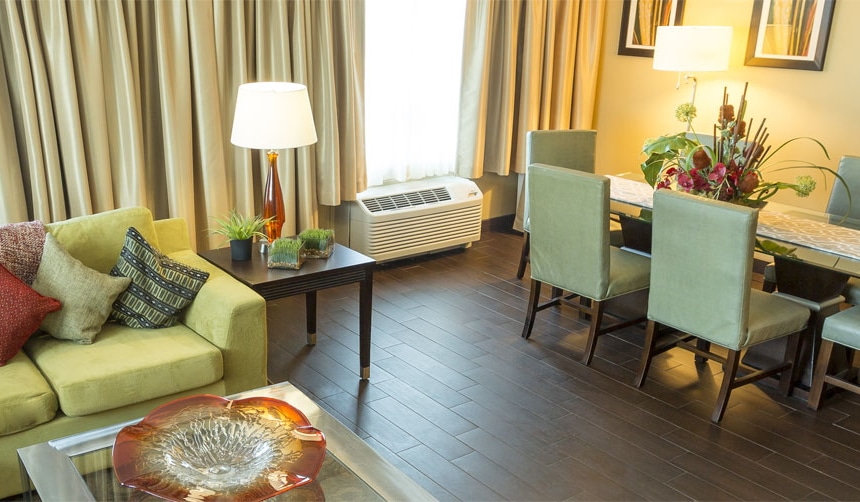
The heat strip is a component that works with the heat pump. The heat pump detects when the temperature reaches a certain threshold, usually around 35°F. At that point, the heat strip kicks in, which are coils that use electricity to produce heat. The air then flows over these heated coils and warms the air in the room. With the heat strip, you will want one that will not use too much energy when heating the air. The Amana heat strips use about 3.5 kW of power, which is very energy-efficient for customers.
One of the most important factors with air conditioners and heat pumps is how much energy the unit will consume when running. With that, you want to consider two types of ratings, EER and COP. An EER (Energy-efficiency Rating) is determined by dividing the BTUs by the wattage. For example, a 12,000 BTU unit that uses 1,200 watts will receive a rating of 10. The higher the EER, the more energy-efficient the unit is. The Amana units rate between 9.5-11.7, with the Amana 12,000 BTU PTH123G having the best ratio between power and efficiency.
The COP rating (Coefficient of Performance) is very similar to EER. It measures how much more efficient a heat pump is to electric-resistant heat with an efficiency of 100%. Most heat pumps range from 2.5-4 on this scale. Higher the number, the more efficient the heat pump is. Amara heat pumps score between 3-3.5 on the COP scale, such as seen with the Amana DigiSmart PTH093G.
The voltage of heat pumps usually falls within a certain range. Most heat pumps require a 240V outlet to operate efficiently. These units provide a high range of voltage when in operation, which can show how much power is being consumed by the unit. It is also important to keep in mind when servicing these units that a certain amount of caution should be practiced. Amana heat pumps require between 208V-230V.
Different models of heat pumps and air conditioners have multiple speeds and modes. Most units will have at least 2 settings, high and low, but some may have other settings. You can come across several modes that allow for customer settings. It is important to consider your setting options when choosing a heat pump. If you want a lot of options, the Amana 17,000 BTU Air Conditioner with Heater provides seven modes. For some people, this is more than needed, so you may be more comfortable with a unit with fewer options.
Another factor to keep in mind is if the Amana heat pump comes with remote control. While remote control is not a dealbreaker for most, it is nice to have. Depending on how large the space you are using the unit in, not having to walk to adjust the unit is a great advantage. They can also be convenient if you are using multiple units in a hotel/motel setting. While not all Amana units come with remote control, you can usually buy one separately. If you go for the Amana 12,000 BTU Through-The-Wall Air Conditioner with Heat Pump, you will have one already included in the package.
The noise is an important factor when picking an air-conditioner and heat pump unit. No one wants a unit that is going to be noisy and keep them awake or distract them from activities. You want to pay attention to the decibel level of the unit. Most Amana air conditioners and heat pumps run at about 25 decibels, including the Amana 12,000 BTU PTH123G, which is slightly louder than a whisper. Other units may go up to 55 decibels, which is slightly louder than the humming of a normal refrigerator. Any unit falling between the 25-55 decibel range is ideal for a relatively quiet running heat pump.
When choosing the Amana heat pump and air conditioner, you also need to look at the unit’s size. Measure the space you will be placing the PTAC unit in to ensure you have the correct size. Most of the Amana PTAC units fit the standard sleeve size of 42” x 16-1/16” x 14-1/8”. There may be some slight variance, so you may need to use spacers to ensure a snug fit.
Some units, such as the Amana 12,000 BTU Through-The-Wall Air Conditioner with Heat Pump, might be smaller in their dimensions, 15-5/8” x 26” x 16-7/8”, meaning you may need to make adjustments to the wall sleeve to ensure that it fits properly. It is important to take proper measurements of the space you will be placing the unit in to ensure you have the correct amount of space for the unit.
As with just about any appliance, air conditioners and heat pumps can wear down over time. They may need service or replacement, and it is important to know what type of warranty you are getting.
Most Amana units come with a 5-year parts warranty and a 1-year replacement warranty. If the whole unit goes bad within a year of purchase, you will be able to get a replacement for free.
Also, during the first five years, you can get parts for the unit to replace yourself or have the unit serviced.
| Square Footage | BTUs |
| 100 to 150 | 5,000 |
| 150 to 200 | 6,000 |
| 200 to 250 | 7,000 |
| 300 to 350 | 8,000 |
| 350 to 400 | 9,000 |
| 400 to 450 | 10,000 |
| 450 to 550 | 12,000 |
| 550 to 700 | 14,000 |
| 700 to 1,000 | 18,000 |
| 1,000 to 1,200 | 21,000 |
| 1,200 to 1,400 | 23,000 |
| 1,400 to 1,500 | 24,000 |
| 1,500 to 2,000 | 30,000 |
| 2,000 to 2,500 | 34,000 |
After reviewing these heat pumps, we narrowed it down to the three best units. Here are our top picks.
Our Editor’s Choice is the Amana 12,000 BTU Through-The-Wall Air Conditioner. It has an easy-to-maintain design, a quiet running fan, and comes with an electronic touchpad and remote control to easily set the temperature of your heat pump.
As the Upgrade Pick, we chose the Amana 17,000 BTU Air Conditioner with Heater. The 17,000 BTUs and the Eden control system allow for a lot of power without consuming too much energy.
Another model worth considering is the Amana PTAC 15,000 BTU Air Conditioner Unit. This model is quiet and energy-efficient, which makes it perfect for guest rooms to keep everyone comfortable. Its ability to easily fit into most wall sleeves makes it simple to install.
When you choose a new air conditioner or heating pump, you cannot go wrong with Amana. With the help of our Amana heat pump reviews, you can find the perfect system for your needs.
